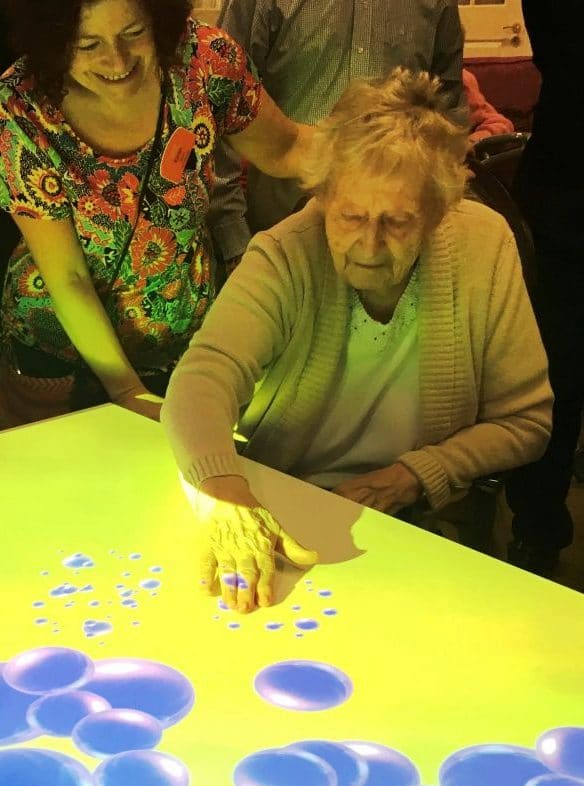
The benefits of engaging with a dedicated sensory space don’t go away as most people age. Quite the opposite, in fact! Many seniors find that as they age, they are more likely to benefit from and enjoy spending time in a sensory room. Whether they are experiencing cognitive shifts or physical ones, there are many benefits to spending time in a sensory room.
Can sensory rooms benefit adults?
While the use of sensory rooms is common for children both at home and in school settings, they are invaluable tools serving disabled adults and seniors groups. Sensory environments are very beneficial for the elderly, particularly those challenged with dementia or other special needs.
The needs of adults will vary from those of children using a sensory room, but the benefits are quite similar. Sensory rooms and sensory stimulation can help adults:
- Feel safe and comfortable in the space they are in
- Have a comfortable space in which to experience therapy, either one on one or with a group
- Participate in social groups and combat isolation
- Engage in activities that improve cognition and functionality
- Facilitate communication both with peers and their support system
- Explore avenues for increased concentration, focus and alertness
- Maintain physical abilities and dexterity
- Learn skills related to problem solving, self-care, and crisis prevention and de-escalation
Sensory environments support neurodegenerative diseases
As people age there is a natural decrease in autonomy that can limit a person’s ability to maintain freedom and mobility. As this is often gradual, a person is usually able to get used to the restrictions as time goes on. However, when a neurodegenerative disease like dementia or Alzheimer’s takes hold deterioration in autonomy can become significant quickly, which leads mental struggle for the sufferer.
Sensory rooms are quite beneficial in these situations. When a person is frustrated with their newfound struggles, the ability to step into a sensory room and leave those frustrations at the door will offer a significant mental health break.
Spending time in a no-pressure zone with the opportunity to immerse in things that make them happy will leave a visitor better equipped to handle their changing lives outside the room. Therapy interventions for these individuals can also be easier to approach in a space where they are calmer and more relaxed.
How does technology improve sensory rooms?
Although a sensory room can be created using non-technological items, there are some extraordinary new tools on the market that can help improve a user’s experience.
Virtual reality is a great way to entertain and engage sensory room users. With the BroomX MK360 offering a completely immersive experience with no headsets, visitors can feel the calming effects of the tool just by stepping into the room. The images can be changed and customized to the user, allowing for a completely unique and targeted therapeutic experience. Virtual reality helps to engage a viewer emotionally, socially and cognitively, resulting in significant benefits especially in those with Dementia, Alzheimer’s, autism spectrum disorder and other special needs.
A projection system is another excellent piece of modern technology that can offer sensory room users a significant benefit. An Omi motion-activated projection system will display chosen images, sounds and music onto any flat surface for the enjoyment of the user. With a customizable display, users can experience cognitive, social, physical and emotional stimulation, resulting in a more calm and positive mood. This is especially helpful for those experiencing dementia, as the system allows the user to experience places and things that invoke happy and calming thoughts and memories.
Elderly people often experience a loss of senses
Often as people age, they start to experience a reduction or loss of some of their senses. A gradual loss of mobility, loss of hearing, loss of sight, and even loss of the sense of touch can all affect the mindset of a person. A sensory room offers a person the ability to retreat into a space where they are able to both focus on the senses they do still have full control over, and spend time gently stimulating the senses that are reducing. This focused and non-pressured attention can help users to feel more confident and comfortable in their everyday lives.
Sensory rooms are helpful for all ages
Although sensory rooms are commonly found in schools, there is significant benefit to exploring the opportunity to create them in long-term care and hospital settings as well. When a senior is offered the opportunity to take a pause from all the stressors in their life for a limited time frame, they are likely to return to the original scenario better equipped to handle it.
Elderly people and those dealing with varied needs and abilities are most likely to benefit from the variety of sensory stimulation found in sensory rooms. Technology like virtual reality and projection systems can help facilitators to provide a customized and focused therapy plan in order to assist the individual in their day to day life.



